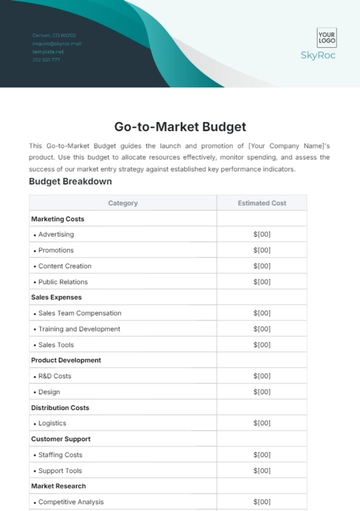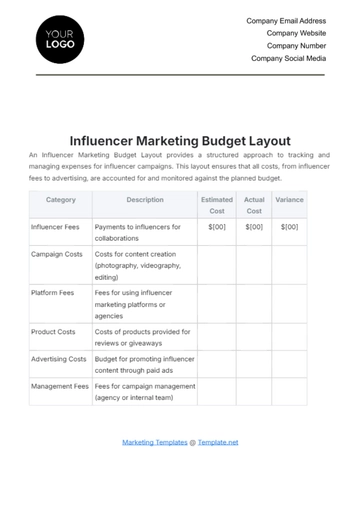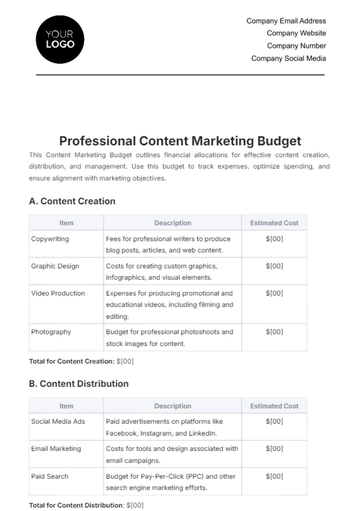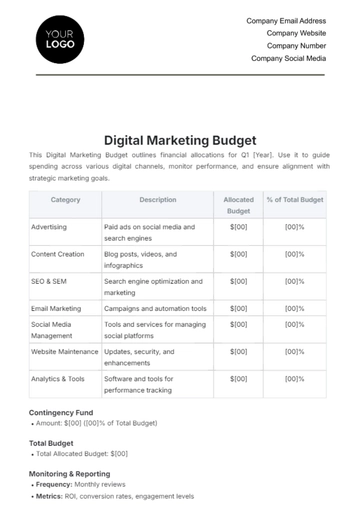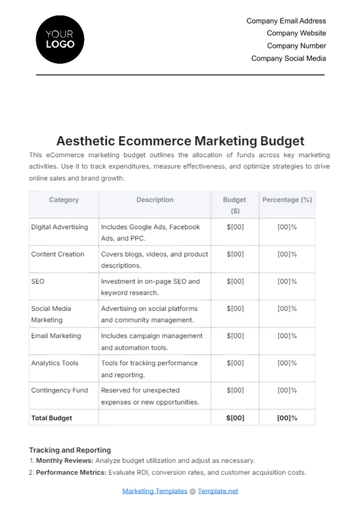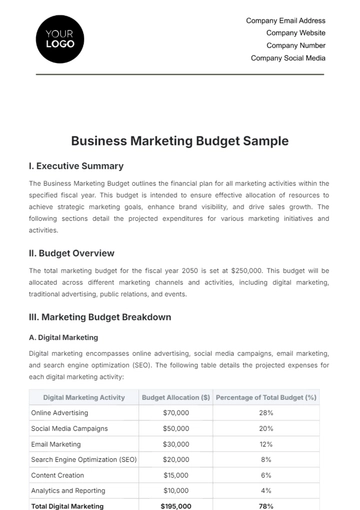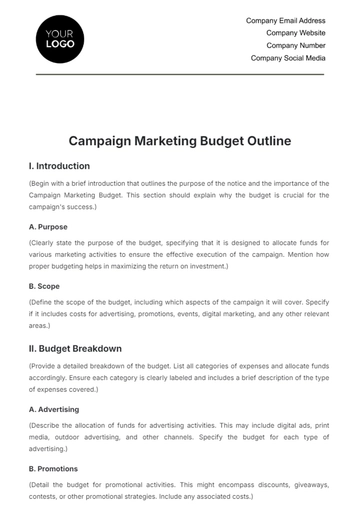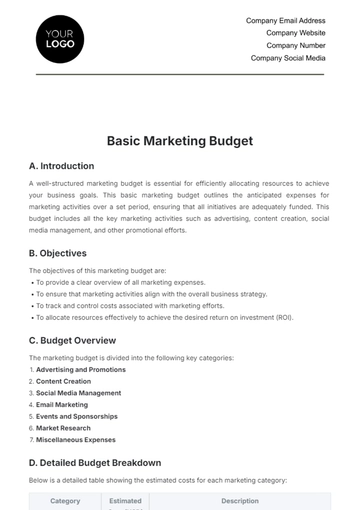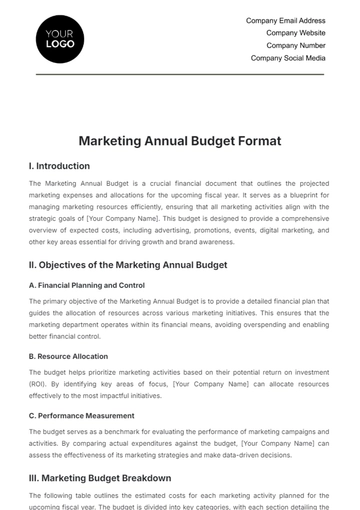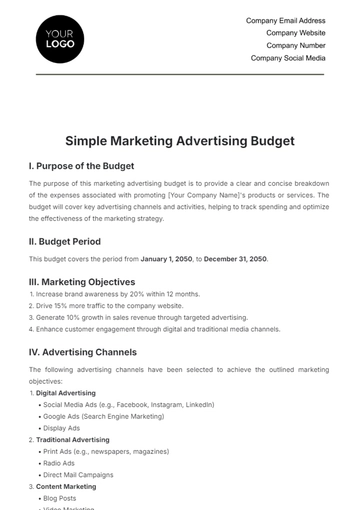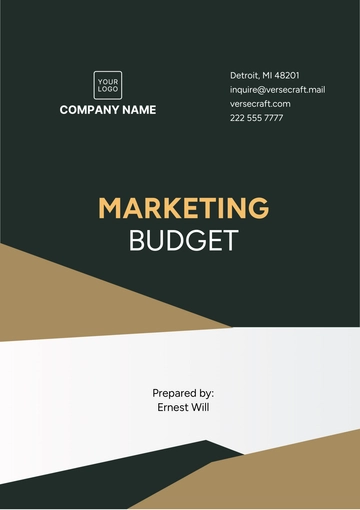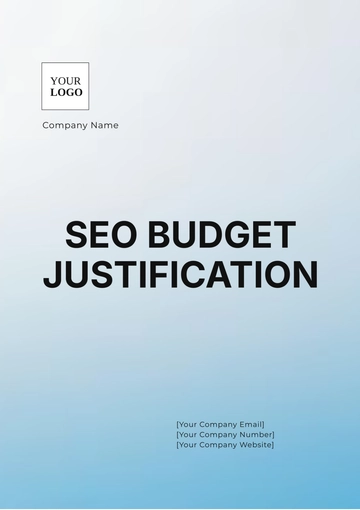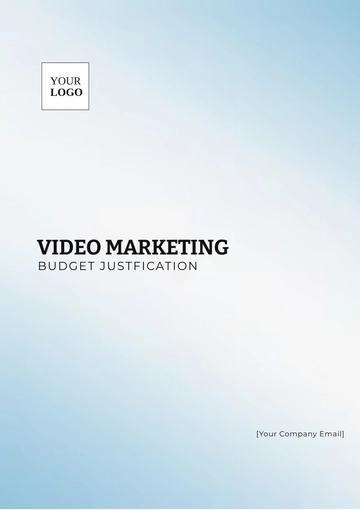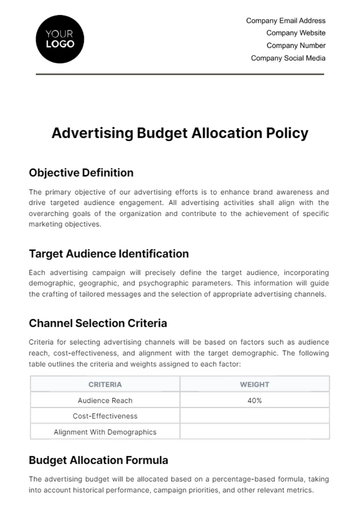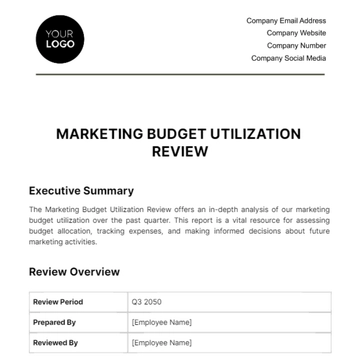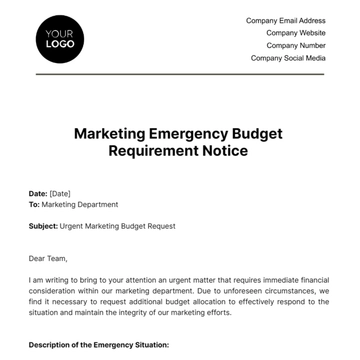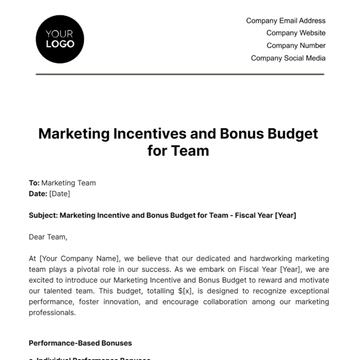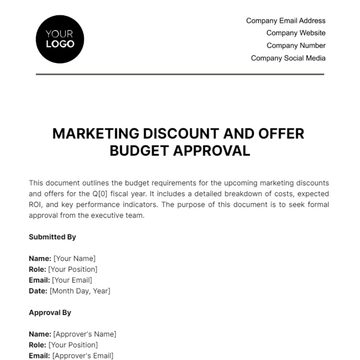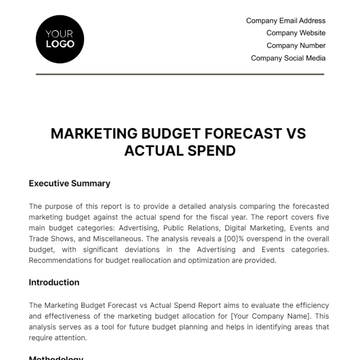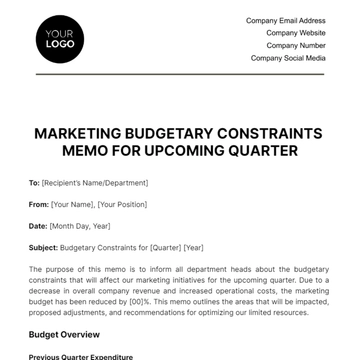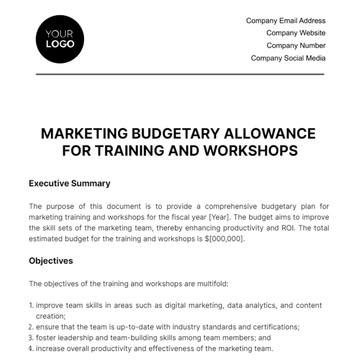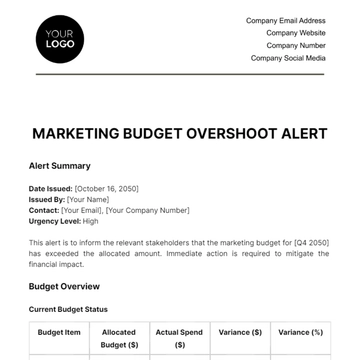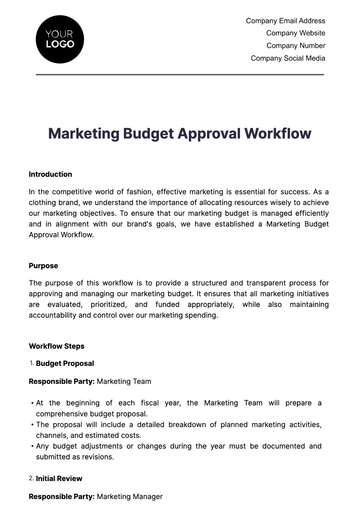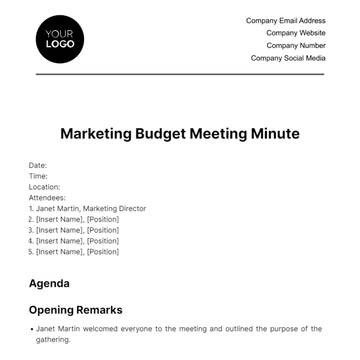Free Marketing Budget

I. Budget Overview
The marketing budget for [Your Company Name] is designed to support the achievement of strategic goals, such as increasing brand awareness, generating leads, and driving sales. The budget covers all planned marketing activities for the fiscal year 2051, ensuring that resources are allocated efficiently to maximize return on investment (ROI).
A. Financial Summary
The total marketing budget for the fiscal year 2051 is projected at $500,000. This budget is distributed across various categories, each corresponding to a key marketing area, including digital marketing, traditional advertising, public relations, content creation, and event marketing.
Table 1: Marketing Budget Summary
Category | Allocated Budget | Percentage of Total Budget |
|---|---|---|
Digital Marketing | $200,000 | 40% |
Traditional Advertising | $100,000 | 20% |
Public Relations | $50,000 | 10% |
Content Creation | $75,000 | 15% |
Event Marketing | $75,000 | 15% |
Total | $500,000 | 100% |
B. Budget Allocation by Channel
To ensure a balanced approach, the budget is allocated across various channels. The following subsections break down the investment by specific marketing channels within each category.
II. Digital Marketing Budget
Digital marketing is a significant focus for [Your Company Name], given its potential for high ROI and precise targeting capabilities. The budget for digital marketing is allocated to various online channels, including social media, search engine marketing (SEM), email marketing, and display advertising.
Table 2: Digital Marketing Budget Allocation
Channel | Allocated Budget | Percentage of Digital Marketing Budget |
|---|---|---|
Social Media Marketing | $80,000 | 40% |
Search Engine Marketing (SEM) | $60,000 | 30% |
Email Marketing | $30,000 | 15% |
Display Advertising | $30,000 | 15% |
Total | $200,000 | 100% |
A. Social Media Marketing
A significant portion of the digital marketing budget is dedicated to social media platforms such as Facebook, Instagram, LinkedIn, and Twitter. These platforms will be used for both organic and paid campaigns to increase brand visibility and engagement.
B. Search Engine Marketing (SEM)
Search Engine Marketing includes both Pay-Per-Click (PPC) advertising and search engine optimization (SEO) efforts to improve visibility on Google and other search engines. This allocation will drive targeted traffic to [Your Company Name]’s website.
C. Email Marketing
Email marketing remains a cost-effective way to reach and nurture leads. This budget will be used for email list management, campaign design, and automation tools to deliver personalized and timely communications to our audience.
D. Display Advertising
Display ads will be placed on relevant websites and platforms to create brand awareness among target demographics. This allocation covers both retargeting ads and brand awareness campaigns.
III. Traditional Advertising Budget
Despite the digital shift, traditional advertising still plays a vital role in our marketing strategy. This category includes expenditures on television, radio, print media, and outdoor advertising.
Table 3: Traditional Advertising Budget Allocation
Medium | Allocated Budget | Percentage of Traditional Advertising Budget |
|---|---|---|
Television | $50,000 | 50% |
Radio | $20,000 | 20% |
Print Media | $15,000 | 15% |
Outdoor Advertising | $15,000 | 15% |
Total | $100,000 | 100% |
A. Television
Television advertising will focus on key time slots that reach our target audience. This includes local and national campaigns aimed at increasing brand recognition.
B. Radio
Radio ads will target specific markets where our audience is highly concentrated. The budget covers both production and airtime costs.
C. Print Media
Print advertising will be placed in industry-specific publications, magazines, and newspapers that align with our target demographics.
D. Outdoor Advertising
Outdoor advertising will include billboards, transit ads, and other out-of-home placements in high-traffic areas to increase brand exposure.
IV. Public Relations Budget
Public relations efforts are crucial for maintaining and enhancing the brand image of [Your Company Name]. This budget covers media relations, press releases, and sponsorships.
Table 4: Public Relations Budget Allocation
Activity | Allocated Budget | Percentage of Public Relations Budget |
|---|---|---|
Media Relations | $25,000 | 50% |
Press Releases | $15,000 | 30% |
Sponsorships & Partnerships | $10,000 | 20% |
Total | $50,000 | 100% |
A. Media Relations
This allocation supports ongoing efforts to build and maintain relationships with key media outlets, journalists, and influencers.
B. Press Releases
Funds will be used to draft, distribute, and monitor press releases that announce significant company developments and product launches.
C. Sponsorships & Partnerships
Sponsorships and strategic partnerships will be pursued to enhance brand visibility and align [Your Company Name] with relevant causes and events.
V. Content Creation Budget
Content is at the core of our marketing strategy. This budget supports the creation of high-quality content, including blog posts, videos, infographics, and eBooks, that drives engagement and generates leads.
Table 5: Content Creation Budget Allocation
Content Type | Allocated Budget | Percentage of Content Creation Budget |
|---|---|---|
Blog Posts & Articles | $25,000 | 33.3% |
Video Production | $30,000 | 40% |
Infographics & Visuals | $10,000 | 13.3% |
eBooks & Whitepapers | $10,000 | 13.3% |
Total | $75,000 | 100% |
A. Blog Posts & Articles
Investments in blog posts and articles will focus on topics relevant to our industry, providing value to our audience and improving our search engine rankings.
B. Video Production
Video content will be used for marketing campaigns, product demonstrations, and customer testimonials, leveraging platforms like YouTube and social media.
C. Infographics & Visuals
Infographics and visual content will simplify complex information, making it more accessible and shareable across platforms.
D. eBooks & Whitepapers
eBooks and whitepapers will be used as lead magnets, providing in-depth insights on industry trends, challenges, and solutions.
VI. Event Marketing Budget
Events play a vital role in engaging with our target audience directly. This budget covers trade shows, conferences, webinars, and other event-related activities.
Table 6: Event Marketing Budget Allocation
Event Type | Allocated Budget | Percentage of Event Marketing Budget |
|---|---|---|
Trade Shows | $30,000 | 40% |
Conferences | $25,000 | 33.3% |
Webinars | $10,000 | 13.3% |
Product Launch Events | $10,000 | 13.3% |
Total | $75,000 | 100% |
A. Trade Shows
Participating in trade shows will help [Your Company Name] showcase products, network with potential clients, and generate leads.
B. Conferences
Attendance and sponsorship of industry conferences will position [Your Company Name] as a thought leader in the market.
C. Webinars
Webinars will be used to educate our audience, demonstrate expertise, and generate high-quality leads.
D. Product Launch Events
Product launch events will be strategically planned to generate excitement and media coverage for new products or services.
- 100% Customizable, free editor
- Access 1 Million+ Templates, photo’s & graphics
- Download or share as a template
- Click and replace photos, graphics, text, backgrounds
- Resize, crop, AI write & more
- Access advanced editor
Manage your marketing finances with the Marketing Budget Template from Template.net. This editable and customizable template offers a structured approach to planning and tracking your marketing expenses. Use our Ai Editor Tool to tailor the budget to your needs, ensuring effective allocation and management of marketing resources.
You may also like
- Budget Sheet
- Personal Budget
- Non Profit Budget
- Monthly Budget
- Project Budget
- HR Budget
- Company Budget
- Home Budget
- Weekly Budget
- College Budget
- Business Budget
- Construction Budget
- Small Business Budget
- Hotel Budget
- Annual Budget
- Home Renovation Budget
- Household Budget
- Student Budget
- Grocery Budget
- Marketing Budget
- Corporate Budget
- Startup Budget
- Manufacturing Budget
- Church Budget
- University Budget
- Annual Budget Plan
- Event Budget
- Operating Budget
- Travel Budget
- Food Budget
- IT and Software Budget
- School Budget
- Real Estate Budget
- Sales Budget
- Conference Budget
- Budget Finance
- Freelancer Budget
- Budget Advertising


